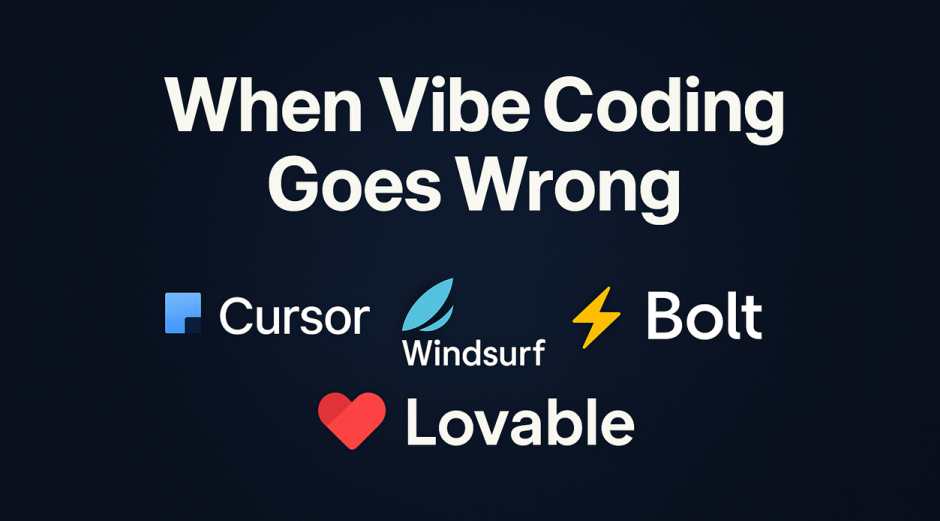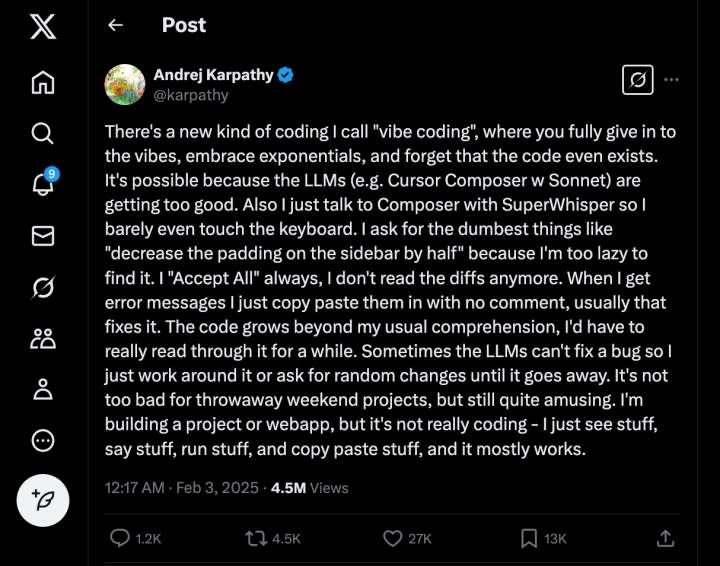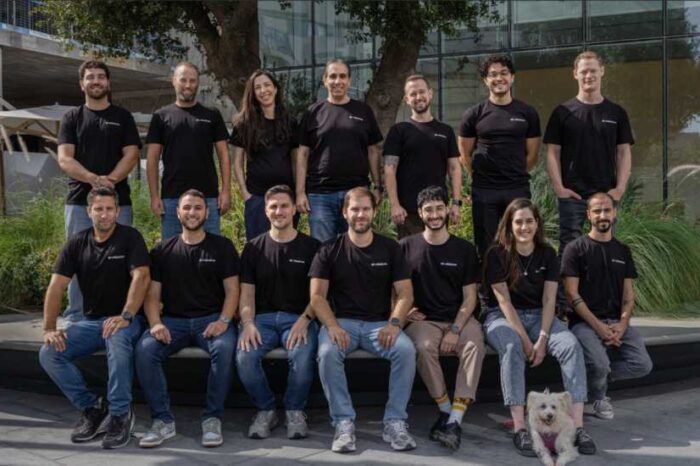When Vibe Coding Goes Wrong

In early February 2025, Andrej Karpathy—co-founder of OpenAI and a widely respected computer scientist—posted something that lit a spark: “Vibe coding.” The post quickly garnered over 4.5 million views.
“There’s a new kind of coding I call “vibe coding”, where you fully give in to the vibes, embrace exponentials, and forget that the code even exists. It’s possible because the LLMs (e.g. Cursor Composer w Sonnet) are getting too good. Also I just talk to Composer with SuperWhisper so I barely even touch the keyboard. I ask for the dumbest things like “decrease the padding on the sidebar by half” because I’m too lazy to find it,” Karpathy shared on X.

The idea was simple but bold: using AI tools like Cursor Composer and large language models (LLMs) to write code through plain language prompts. It caught fire instantly. Karpathy described it as a process where “you fully give in to the vibes, embrace exponentials, and forget that the code even exists.” Within hours, Silicon Valley was all in.
What’s Vibe Coding?
At its core, vibe coding is the practice of writing software by speaking or typing plain language instructions to an AI, which then generates the actual code. Instead of fussing with syntax or structure, developers describe what they want—like “add a login form” or “make the sidebar narrower”—and the AI builds it. The term was coined by Karpathy, who encouraged developers to “give in to the vibes” and let the AI handle the rest.
The Promise of Vibe Coding
The pitch was seductive: talk to an AI, and get code instantly. Karpathy’s excitement was contagious—skip the syntax, just describe what you want, and let the AI fill in the rest. Developers, founders, and hobbyists rushed in.
People on X shared glowing first impressions. One post read: “Its literally crazy whats happening, i can’t believe it. Just built industry grade web app in 4 days with cursor and claude code for less than 100usd. This is literally crazy!” Some founders with zero coding experience were suddenly launching startups from scratch. For experienced developers, it became a productivity booster—AI handled the tedious stuff while they focused on ideas.
The appeal was obvious: less typing, faster results, and a sense of freedom. Karpathy himself bragged about using voice commands like “decrease the padding on the sidebar by half” because he didn’t want to touch the keyboard. Suddenly, anyone could build something. Or so it seemed.
We tried vibe coding ourselves using DeepSeek. Our prompt was simple: “You are a website developer. Code a modern, small digital marketing landing page.” The result? Surprisingly solid—here’s what it built.
Why AI-Generated Code Often Breaks Down
As more people tried it, the shine wore off. What felt magical at first often turned into frustration. One user wrote: “It was very fun for the first 30 minutes, but after a while you start to hit walls. The AI is writing slop, and it’s causing all kinds of annoying bugs and issues.”
Others echoed the same sentiment: fast doesn’t mean right. The code might work, but it often doesn’t. AI-generated code can get bloated, repetitive, and messy. And when bugs pop up, fixing them becomes an exercise in futility. One user summed it up like this: “It’s still not fixed… yeah, you just did the same thing 2 prompts ago that was wrong then and wrong now.”
Debugging with AI—what some now call “vibe debugging”—can feel like asking the same question over and over, hoping for a better answer that never comes. You end up stuck in a loop, with vague fixes that don’t address the real problem.
The Hidden Risks Behind AI-Assisted Coding Tools
A few tech publications have looked into what’s really going on. According to Business Insider, vibe coding demands more than casual prompting. It requires clear thinking, strong communication, and an understanding of patterns—skills not everyone has. Without those, users feed vague requests into the AI and get garbage back.
ZDNET warned that it “feels like magic—until your AI assistant starts overwriting your work.” That’s especially risky for beginners, who don’t always know what the AI is doing behind the scenes. One developer wrote, “The more you generate, the more bugs creep in.” Another added, “You stop learning. You just copy-paste and hope it works.”
Bloomberg pointed out that businesses shouldn’t rush to replace developers just yet. These AI tools might be fast, but they’re still unreliable in high-stakes environments.
Security Risks of Vibe Coding for Non-Technical Builders
Then there’s security. On March 15, a user named Leo proudly shared that his entire SaaS was built with Cursor. No hand-written code. And yes—people were paying for it.
my saas was built with Cursor, zero hand written code
AI is no longer just an assistant, it’s also the builder
Now, you can continue to whine about it or start building.
P.S. Yes, people pay for it
— leo (@leojr94_) March 15, 2025
Just two days later, things went south. “Guys, I’m under attack,” he posted. API keys were getting maxed out, people were bypassing his paywall, and his database was filling up with junk. “As you know, I’m not technical,” he admitted, saying he’d stop sharing details about his project because of “weird ppl out there.”
guys, i’m under attack
ever since I started to share how I built my SaaS using Cursor
random thing are happening, maxed out usage on api keys, people bypassing the subscription, creating random shit on db
as you know, I’m not technical so this is taking me longer that usual to…
— leo (@leojr94_) March 17, 2025
Indie Hackers covered his story in detail. His app had obvious flaws—public API keys, a paywall that could be bypassed, and other rookie mistakes. The article warned that fast-built projects like Leo’s are easy targets for attackers. Another user on X put it bluntly: “If you’re vibe coding and don’t know code… your app can get bloated and have security issues.”
A Yahoo piece added that non-technical users might ask for something like “a secure database” and get something half-baked that fails under pressure. The result? Stress, data leaks, and money down the drain.
Then comes the issue of scaling. As developer Mehul Gupta put it on Medium: “Vibe coding is great for toy projects. But if you’re building something real? Reality hits differently.” Karpathy might be able to manage the mess. Most can’t.
Vibe Coding Hype vs. Reality
There’s no doubt that vibe coding is interesting. It taps into a real desire for faster, easier development. But there’s a gap between what it promises and what it actually delivers—especially for people without deep technical experience.
As GeekWire warned startups earlier this month, tread carefully. The idea of 10 engineers doing the work of 100 sounds great. But if your app crashes, leaks data, or turns into an unfixable spaghetti mess, was it worth it?
Still, all this chaos might spark better tools down the line. Wired noted that the frustration is pushing developers to demand smarter, safer AI coding assistants—ones that don’t just spit out quick fixes, but understand what they’re doing.
For now, vibe coding works best for low-stakes experiments—weekend side projects, quick prototypes, things you don’t mind throwing away. Just know that if you go all-in without knowing what you’re doing, the vibes can go bad fast.
A Cautionary Tale
Vibe coding’s meteoric rise reflects a real leap in AI-assisted development—but it comes with strings attached. Sloppy code, frustrating debugging cycles, and security gaps have quickly tempered the excitement. As GeekWire put it on March 20, 2025: “Approach with caution.” The idea that 10 engineers could outperform 100 sounds incredible on paper. In practice, though, it often falls apart—just ask users like Leo.
Still, the chaos is fueling something important. Wired suggested on March 25 that these early stumbles may lead to smarter, safer tools in the future—tools that balance speed with structure, and creativity with security.
For now, vibe coding has its place: weekend hacks, quick MVPs, and early prototypes. But if you’re building something meant to last, you might want to hold off on giving in to the vibes—at least until the tools catch up.




